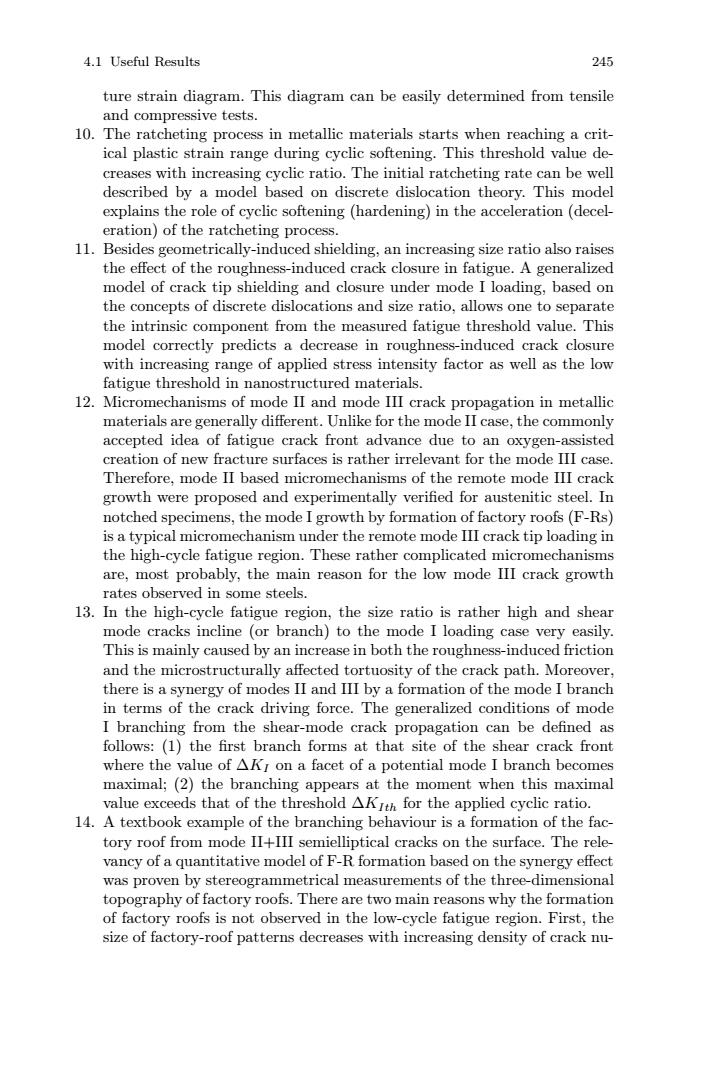正在加载图片...

4.1 Useful Results 245 ture strain diagram.This diagram can be easily determined from tensile and compressive tests. 10.The ratcheting process in metallic materials starts when reaching a crit- ical plastic strain range during cyclic softening.This threshold value de- creases with increasing cyclic ratio.The initial ratcheting rate can be well described by a model based on discrete dislocation theory.This model explains the role of cyclic softening (hardening)in the acceleration(decel- eration)of the ratcheting process. 11.Besides geometrically-induced shielding,an increasing size ratio also raises the effect of the roughness-induced crack closure in fatigue.A generalized model of crack tip shielding and closure under mode I loading,based on the concepts of discrete dislocations and size ratio,allows one to separate the intrinsic component from the measured fatigue threshold value.This model correctly predicts a decrease in roughness-induced crack closure with increasing range of applied stress intensity factor as well as the low fatigue threshold in nanostructured materials. 12.Micromechanisms of mode II and mode III crack propagation in metallic materials are generally different.Unlike for the mode II case,the commonly accepted idea of fatigue crack front advance due to an oxygen-assisted creation of new fracture surfaces is rather irrelevant for the mode III case. Therefore,mode II based micromechanisms of the remote mode III crack growth were proposed and experimentally verified for austenitic steel.In notched specimens,the mode I growth by formation of factory roofs(F-Rs) is a typical micromechanism under the remote mode III crack tip loading in the high-cycle fatigue region.These rather complicated micromechanisms are,most probably,the main reason for the low mode III crack growth rates observed in some steels. 13.In the high-cycle fatigue region,the size ratio is rather high and shear mode cracks incline (or branch)to the mode I loading case very easily. This is mainly caused by an increase in both the roughness-induced friction and the microstructurally affected tortuosity of the crack path.Moreover, there is a synergy of modes II and III by a formation of the mode I branch in terms of the crack driving force.The generalized conditions of mode I branching from the shear-mode crack propagation can be defined as follows:(1)the first branch forms at that site of the shear crack front where the value of AKr on a facet of a potential mode I branch becomes maximal;(2)the branching appears at the moment when this maximal value exceeds that of the threshold AKIth for the applied cyclic ratio. 14.A textbook example of the branching behaviour is a formation of the fac- tory roof from mode II+III semielliptical cracks on the surface.The rele- vancy of a quantitative model of F-R formation based on the synergy effect was proven by stereogrammetrical measurements of the three-dimensional topography of factory roofs.There are two main reasons why the formation of factory roofs is not observed in the low-cycle fatigue region.First,the size of factory-roof patterns decreases with increasing density of crack nu-4.1 Useful Results 245 ture strain diagram. This diagram can be easily determined from tensile and compressive tests. 10. The ratcheting process in metallic materials starts when reaching a critical plastic strain range during cyclic softening. This threshold value decreases with increasing cyclic ratio. The initial ratcheting rate can be well described by a model based on discrete dislocation theory. This model explains the role of cyclic softening (hardening) in the acceleration (deceleration) of the ratcheting process. 11. Besides geometrically-induced shielding, an increasing size ratio also raises the effect of the roughness-induced crack closure in fatigue. A generalized model of crack tip shielding and closure under mode I loading, based on the concepts of discrete dislocations and size ratio, allows one to separate the intrinsic component from the measured fatigue threshold value. This model correctly predicts a decrease in roughness-induced crack closure with increasing range of applied stress intensity factor as well as the low fatigue threshold in nanostructured materials. 12. Micromechanisms of mode II and mode III crack propagation in metallic materials are generally different. Unlike for the mode II case, the commonly accepted idea of fatigue crack front advance due to an oxygen-assisted creation of new fracture surfaces is rather irrelevant for the mode III case. Therefore, mode II based micromechanisms of the remote mode III crack growth were proposed and experimentally verified for austenitic steel. In notched specimens, the mode I growth by formation of factory roofs (F-Rs) is a typical micromechanism under the remote mode III crack tip loading in the high-cycle fatigue region. These rather complicated micromechanisms are, most probably, the main reason for the low mode III crack growth rates observed in some steels. 13. In the high-cycle fatigue region, the size ratio is rather high and shear mode cracks incline (or branch) to the mode I loading case very easily. This is mainly caused by an increase in both the roughness-induced friction and the microstructurally affected tortuosity of the crack path. Moreover, there is a synergy of modes II and III by a formation of the mode I branch in terms of the crack driving force. The generalized conditions of mode I branching from the shear-mode crack propagation can be defined as follows: (1) the first branch forms at that site of the shear crack front where the value of ΔKI on a facet of a potential mode I branch becomes maximal; (2) the branching appears at the moment when this maximal value exceeds that of the threshold ΔKIth for the applied cyclic ratio. 14. A textbook example of the branching behaviour is a formation of the factory roof from mode II+III semielliptical cracks on the surface. The relevancy of a quantitative model of F-R formation based on the synergy effect was proven by stereogrammetrical measurements of the three-dimensional topography of factory roofs. There are two main reasons why the formation of factory roofs is not observed in the low-cycle fatigue region. First, the size of factory-roof patterns decreases with increasing density of crack nu-